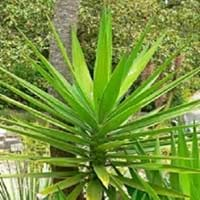Life Span
Perennial
Perennial
Type
Bulb or Corm or Tuber
Shrub
Origin
Hybrid origin
Southwestern United States, Mexico
Types
Not Available
Yucca aloifolia 'Purpurea' , Yucca aloifolia
Habitat
tropical environments
coastal environs, Coastal sand dunes, mild coastal areas
USDA Hardiness Zone
8-11
7-9
AHS Heat Zone
Not Available
9-7
Sunset Zone
21,22
2a, 2b, 3a, 3b, 4, 5, 6, 7, 8, 9, 10, 11, 12, 13, 14, 15, 16, 17, 18, 19, 20, 21, 22, 23, 24
Habit
Clump-Forming
Rosette/Stemless
Minimum Height
Not Available
Minimum Width
Not Available
Flower Color
White, Red, Light Pink
White
Flower Color Modifier
Bicolor
Not Available
Fruit Color
Green, Brown
Brown
Leaf Color in Spring
Green, Dark Green
Blue Green
Leaf Color in Summer
Light Green
Blue Green
Leaf Color in Fall
Several shades of Green
Blue Green
Leaf Color in Winter
Light Green
Blue Green
Leaf Shape
Long Linear
long with sharp edges
Plant Season
Spring, Summer, Winter
Spring, Summer, Fall, Winter
Sunlight
Full Sun, Partial Sun
Full Sun
Growth Rate
Medium
Very Slow
Type of Soil
Loam, Sand
Loam, Sand
The pH of Soil
Acidic, Neutral
Acidic, Neutral, Alkaline
Soil Drainage
Well drained
Well drained
Bloom Time
Not Available
Late Spring, Early Summer
Tolerances
Deer resistant
Drought, Salt
Where to Plant?
Container, Ground, Pot
Ground
How to Plant?
Divison, From Rhizomes, Tubers
Cuttings, Divison
Plant Maintenance
Low
Medium
Watering Requirements
Average Water Needs
Keep the Soil well drained, Needs very little water
In Summer
Lots of watering
Lots of watering
In Spring
Moderate
Moderate
In Winter
Average Water
Average Water
Soil pH
Acidic, Neutral
Acidic, Neutral, Alkaline
Soil Type
Loam, Sand
Loam, Sand
Soil Drainage Capacity
Well drained
Well drained
Sun Exposure
Full Sun, Partial Sun
Full Sun
Pruning
Cut or pinch the stems, Remove damaged leaves, Remove dead branches, Remove dead leaves
Remove damaged leaves, Remove dead branches, Remove dead leaves
Fertilizers
as it is a flowering plant, use high phosphorous content fertilizer, Nitrogen, Phosphorous, Potassium, Requires high amount of nitrogen
All-Purpose Liquid Fertilizer
Pests and Diseases
Aphids, Grasshoppers, Mealybugs, Mites, Red blotch, Slugs, Snails
Leaf spot, Scale
Plant Tolerance
Deer resistant
Drought, Salt
Flower Petal Number
Not Available
Single
Edible Fruit
Not Available
Yes
Fragrant Flower
Not Available
Yes
Foliage Texture
Medium
Bold
Foliage Sheen
Glossy
Matte
Attracts
Bees, Butterflies, Hummingbirds
Butterflies, Not Available
Allergy
poisonous if ingested
Unknown
Aesthetic Uses
Beautification, Bouquets, Cottage Garden, Showy Purposes
Borders, Cottage Garden, Wild gardens, Woodland margins
Beauty Benefits
Not Available
Not Available
Environmental Uses
Not Available
Air purification
Medicinal Uses
Not Available
No Medicinal Use
Part of Plant Used
Flowers
Not Available
Other Uses
Used as Ornamental plant, Used for bedding in gardens
Beneficial species for attracting pollinators
Used As Indoor Plant
Yes
No
Used As Outdoor Plant
Yes
Yes
Garden Design
Container, Cutflower, Houseplant, Mixed Border, Tropical
Rock Garden, Wall, Wildflower
Botanical Name
HIPPEASTRUM 'Picotee'
Yucca gloriosa
Common Name
Florist Amaryllis, Hippeastrum, Picotee Hippeastrum
spanish dagger
In Hindi
HIPPEASTRUM
Spanish Bayonet
In German
HIPPEASTRUM
Spanish Bayonet
In French
HIPPEASTRUM
Spanish bayonet
In Spanish
Hippeastrum
Spanish bayonet
In Greek
Hippeastrum
Spanish bayonet
In Portuguese
HIPPEASTRUM
Spanish bayonet
In Polish
Hippeastrum
Spanish bayonet
In Latin
Hippeastrum
Spanish bayonet
Phylum
Magnoliophyta
Magnoliophyta
Class
Magnoliopsida
Liliopsida
Order
Asparagales
Liliales
Family
Amaryllidaceae
Agavaceae
Clade
Angiosperms, Monocots
Angiosperms, Monocots
Tribe
Not Available
Not Available
Subfamily
Amaryllidoideae
Agavoideae
Number of Species
Not Available
Difference Between Hippeastrum and Spanish Bayonet
If you are confused whether Hippeastrum or Spanish Bayonet are same, here are some features about those plants to help you choose better. Many people think that these two plants have the same characteristics, but one can see Hippeastrum and Spanish Bayonet Information and learn more about it. Fertilizers required for proper growth of Hippeastrum are as it is a flowering plant, use high phosphorous content fertilizer, Nitrogen, Phosphorous, Potassium and Requires high amount of nitrogen, whereas for Spanish Bayonet fertilizers required are All-Purpose Liquid Fertilizer. Hence, one should know the basic difference between Hippeastrum and Spanish Bayonet if you are planning to have them in your garden to enhance its beauty.
<
Flowering PlantsImportance of Hippeastrum and Spanish Bayonet
Want to have the most appropriate plant for your garden? You might want to know the importance of Hippeastrum and Spanish Bayonet. Basically, these two plants vary in many aspects. Compare Hippeastrum and Spanish Bayonet as they differ in many characteristics such as their life, care, benefits, facts, etc. Every gardener must at least have the slightest clue about the plants he wants to plant in his garden. Compare their benefits, which differ in many ways like facts and uses. The medicinal use of Hippeastrum is Not Available whereas of Spanish Bayonet is No Medicinal Use. Hippeastrum has beauty benefits as follows: Not Available while Spanish Bayonet has beauty benefits as follows: Not Available.
Compare Facts of Hippeastrum vs Spanish Bayonet
How to choose the best garden plant for your garden depending upon its facts? Here garden plant comparison will help you to solve this query. Compare the facts of Hippeastrum vs Spanish Bayonet and know which one to choose. As garden plants have benefits and other uses, allergy is also a major drawback of plants for some people. Allergic reactions of Hippeastrum are poisonous if ingested whereas of Spanish Bayonet have Unknown respectively. Having a fruit bearing plant in your garden can be a plus point of your garden. Hippeastrum has no showy fruits and Spanish Bayonet has showy fruits. Also Hippeastrum is not flowering and Spanish Bayonet is not flowering . You can compare Hippeastrum and Spanish Bayonet facts and facts of other plants too.





